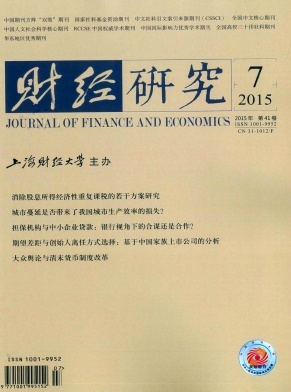城市蔓延是否带来了我国城市生产效率的损失?——基于夜间灯光数据的实证研究
财经研究 2015 年 第 41 卷第 07 期, 页码:
摘要
参考文献
摘要
城市蔓延的经济与社会影响是城市经济学的前沿研究主题之一。其中,关于城市蔓延对生产率作用的研究,学术界存在较大分歧,且相关研究多见于理论分析,基于大量城市样本特别是中国数据的实证研究很少。本文使用2000-2012年中国地级城市层面的面板数据,借助全球夜间灯光数据构造了专门的城市蔓延指数,并运用混合截面回归、面板随机效应回归和工具变量法进行了多角度的稳健性检验,最终证实:来自中国的证据明确地支持了城市蔓延不利于生产率提高的结论,其深层含义是当前我国城市内部还普遍存在空间集聚经济效应。此外,研究还发现了一个有趣的现象:随着城市化的推进,城市蔓延对生产率的负面影响似乎在逐渐减弱。
[1]范剑勇. 产业集聚与地区间劳动生产率差异[J].经济研究,2006,(11):72—81.
[2]范剑勇,石灵云. 产业外部性、企业竞争环境与劳动生产率[J].管理世界,2009,(8):65—73,187.
[3]郭琪,贺灿飞. 密度、距离、分割与城市劳动生产率——基于中国2004-2009年城市面板数据的经验研究[J].中国软科学,2012,(11):77—86.
[4]柯善咨,姚德龙. 工业集聚与城市劳动生产率的因果关系和决定因素——中国城市的空间计量经济联立方程分析[J].数量经济技术经济研究,2008,(12):3—14.
[5]李永乐,吴群. 中国式分权与城市扩张:基于公地悲剧的解释[J].南京农业大学学报(社会科学版),2013,(1):73—79.
[6]刘修岩. 空间效率与区域平衡:对中国省级层面集聚效应的检验[J].世界经济,2014,(1):55—80.
[7]孙晓华,郭玉娇. 产业集聚提高了城市生产率吗?——城市规模视角下的门限回归分析[J].财经研究,2013,(2):103—112.
[8]王家庭,张俊韬. 我国城市蔓延测度:基于35个大中城市面板数据的实证研究[J].经济学家,2010,(10):56—63.
[9]肖文,王平. 外部性、城市规模与城市增长——对长三角地区16个城市的分析[J].浙江学刊,2011,(4):167—173.
[10]杨眉,王世新,周艺等. 基于DMSP/OLS影像的城市化水平遥感估算方法[J].遥感信息,2011,(4):100—106.
[11]杨青山,杜雪,张鹏等. 东北地区市域城市人口空间结构与劳动生产率关系研究[J].地理科学,2011,(11):1301—1306.
[12]Alonso W. The economics of urban size [J]. Papers in Regional Science, 1971,26(1): 67-83.
[13]Brueckner, J. K. and D. A. Fansler. The economics of urban sprawl: Theory and evidence on the spatial sizes of cities[J]. The Review of Economics and Statistics, 1983, 65(3):479-482.
[14]Brulhart M, Sbergami F. Agglomeration and growth: Cross-country evidence [J]. Journal of Urban Economics, 2009, 65(1): 48-63.
[15]Burchfield M, Overman H, Puga D et al. Causes of sprawl:A portrait from space [J].Quarterly Journal of Economics, 2006, 121(2):587-633.
[16]Ciccone A, Hall R. Productivity and the density of economic activity [J]. American Economic Review, 1996, 86(1):54-70.
[17]Fallah B N, Partridge M D, Olfert M R. Urban sprawl and productivity:Evidence from US metropolitan areas [J]. Papers in Regional Science, 2011, 90(3): 451-472.
[18]Glaser E, Khan M.Sprawl and urban growth [M]. Handbook of Regional and Urban Economics, 2003.
[19]Henderson J V, Storeygard A, Weil D N.Measuring economic growth from outer space [J]. American Economic Review, 2012, 102(2):994-1028.
[20]Lucas R, Hansberg R. On the internal structure of cities[J]. Econometrica, 2002, 70(4): 1445-1476.
[21]Porter M. Clusters and the new economics of competition [J]. Harvard Business Review, 1998, 76(6): 77-90.
[22]Ramcharan R. Why an economic core: domestic transport costs [J]. Journal of Economic Geography, 2009, 9(4):559-582.
[23]Sveikauskas L. The productivity of cities [J]. The Quarterly Journal of Economics, 1975,89(3): 393-413.
[2]范剑勇,石灵云. 产业外部性、企业竞争环境与劳动生产率[J].管理世界,2009,(8):65—73,187.
[3]郭琪,贺灿飞. 密度、距离、分割与城市劳动生产率——基于中国2004-2009年城市面板数据的经验研究[J].中国软科学,2012,(11):77—86.
[4]柯善咨,姚德龙. 工业集聚与城市劳动生产率的因果关系和决定因素——中国城市的空间计量经济联立方程分析[J].数量经济技术经济研究,2008,(12):3—14.
[5]李永乐,吴群. 中国式分权与城市扩张:基于公地悲剧的解释[J].南京农业大学学报(社会科学版),2013,(1):73—79.
[6]刘修岩. 空间效率与区域平衡:对中国省级层面集聚效应的检验[J].世界经济,2014,(1):55—80.
[7]孙晓华,郭玉娇. 产业集聚提高了城市生产率吗?——城市规模视角下的门限回归分析[J].财经研究,2013,(2):103—112.
[8]王家庭,张俊韬. 我国城市蔓延测度:基于35个大中城市面板数据的实证研究[J].经济学家,2010,(10):56—63.
[9]肖文,王平. 外部性、城市规模与城市增长——对长三角地区16个城市的分析[J].浙江学刊,2011,(4):167—173.
[10]杨眉,王世新,周艺等. 基于DMSP/OLS影像的城市化水平遥感估算方法[J].遥感信息,2011,(4):100—106.
[11]杨青山,杜雪,张鹏等. 东北地区市域城市人口空间结构与劳动生产率关系研究[J].地理科学,2011,(11):1301—1306.
[12]Alonso W. The economics of urban size [J]. Papers in Regional Science, 1971,26(1): 67-83.
[13]Brueckner, J. K. and D. A. Fansler. The economics of urban sprawl: Theory and evidence on the spatial sizes of cities[J]. The Review of Economics and Statistics, 1983, 65(3):479-482.
[14]Brulhart M, Sbergami F. Agglomeration and growth: Cross-country evidence [J]. Journal of Urban Economics, 2009, 65(1): 48-63.
[15]Burchfield M, Overman H, Puga D et al. Causes of sprawl:A portrait from space [J].Quarterly Journal of Economics, 2006, 121(2):587-633.
[16]Ciccone A, Hall R. Productivity and the density of economic activity [J]. American Economic Review, 1996, 86(1):54-70.
[17]Fallah B N, Partridge M D, Olfert M R. Urban sprawl and productivity:Evidence from US metropolitan areas [J]. Papers in Regional Science, 2011, 90(3): 451-472.
[18]Glaser E, Khan M.Sprawl and urban growth [M]. Handbook of Regional and Urban Economics, 2003.
[19]Henderson J V, Storeygard A, Weil D N.Measuring economic growth from outer space [J]. American Economic Review, 2012, 102(2):994-1028.
[20]Lucas R, Hansberg R. On the internal structure of cities[J]. Econometrica, 2002, 70(4): 1445-1476.
[21]Porter M. Clusters and the new economics of competition [J]. Harvard Business Review, 1998, 76(6): 77-90.
[22]Ramcharan R. Why an economic core: domestic transport costs [J]. Journal of Economic Geography, 2009, 9(4):559-582.
[23]Sveikauskas L. The productivity of cities [J]. The Quarterly Journal of Economics, 1975,89(3): 393-413.
引用本文
秦 蒙, 刘修岩. 城市蔓延是否带来了我国城市生产效率的损失?——基于夜间灯光数据的实证研究[J]. 财经研究, 2015, 41(7): 0.
导出参考文献,格式为:





 8945
8945  5059
5059

